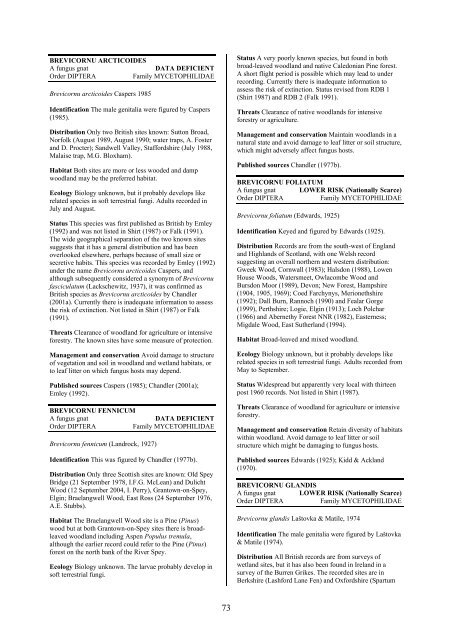Part 2: Nematocera and Aschiza not dealt with by Falk (1991) - JNCC
Part 2: Nematocera and Aschiza not dealt with by Falk (1991) - JNCC
Part 2: Nematocera and Aschiza not dealt with by Falk (1991) - JNCC
Create successful ePaper yourself
Turn your PDF publications into a flip-book with our unique Google optimized e-Paper software.
BREVICORNU ARCTICOIDES<br />
A fungus gnat<br />
DATA DEFICIENT<br />
Order DIPTERA<br />
Family MYCETOPHILIDAE<br />
Brevicornu arcticoides Caspers 1985<br />
Identification The male genitalia were figured <strong>by</strong> Caspers<br />
(1985).<br />
Distribution Only two British sites known: Sutton Broad,<br />
Norfolk (August 1989, August 1990; water traps, A. Foster<br />
<strong>and</strong> D. Procter); S<strong>and</strong>well Valley, Staffordshire (July 1988,<br />
Malaise trap, M.G. Bloxham).<br />
Habitat Both sites are more or less wooded <strong>and</strong> damp<br />
woodl<strong>and</strong> may be the preferred habitat.<br />
Ecology Biology unknown, but it probably develops like<br />
related species in soft terrestrial fungi. Adults recorded in<br />
July <strong>and</strong> August.<br />
Status This species was first published as British <strong>by</strong> Emley<br />
(1992) <strong>and</strong> was <strong>not</strong> listed in Shirt (1987) or <strong>Falk</strong> (<strong>1991</strong>).<br />
The wide geographical separation of the two known sites<br />
suggests that it has a general distribution <strong>and</strong> has been<br />
overlooked elsewhere, perhaps because of small size or<br />
secretive habits. This species was recorded <strong>by</strong> Emley (1992)<br />
under the name Brevicornu arcticoides Caspers, <strong>and</strong><br />
although subsequently considered a synonym of Brevicornu<br />
fasciculatum (Lackschewitz, 1937), it was confirmed as<br />
British species as Brevicornu arcticoides <strong>by</strong> Ch<strong>and</strong>ler<br />
(2001a). Currently there is inadequate information to assess<br />
the risk of extinction. Not listed in Shirt (1987) or <strong>Falk</strong><br />
(<strong>1991</strong>).<br />
Threats Clearance of woodl<strong>and</strong> for agriculture or intensive<br />
forestry. The known sites have some measure of protection.<br />
Management <strong>and</strong> conservation Avoid damage to structure<br />
of vegetation <strong>and</strong> soil in woodl<strong>and</strong> <strong>and</strong> wetl<strong>and</strong> habitats, or<br />
to leaf litter on which fungus hosts may depend.<br />
Published sources Caspers (1985); Ch<strong>and</strong>ler (2001a);<br />
Emley (1992).<br />
BREVICORNU FENNICUM<br />
A fungus gnat<br />
DATA DEFICIENT<br />
Order DIPTERA<br />
Family MYCETOPHILIDAE<br />
Brevicornu fennicum (L<strong>and</strong>rock, 1927)<br />
Identification This was figured <strong>by</strong> Ch<strong>and</strong>ler (1977b).<br />
Distribution Only three Scottish sites are known: Old Spey<br />
Bridge (21 September 1978, I.F.G. McLean) <strong>and</strong> Dulicht<br />
Wood (12 September 2004, I. Perry), Grantown-on-Spey,<br />
Elgin; Braelangwell Wood, East Ross (24 September 1976,<br />
A.E. Stubbs).<br />
Habitat The Braelangwell Wood site is a Pine (Pinus)<br />
wood but at both Grantown-on-Spey sites there is broadleaved<br />
woodl<strong>and</strong> including Aspen Populus tremula,<br />
although the earlier record could refer to the Pine (Pinus)<br />
forest on the north bank of the River Spey.<br />
Ecology Biology unknown. The larvae probably develop in<br />
soft terrestrial fungi.<br />
Status A very poorly known species, but found in both<br />
broad-leaved woodl<strong>and</strong> <strong>and</strong> native Caledonian Pine forest.<br />
A short flight period is possible which may lead to under<br />
recording. Currently there is inadequate information to<br />
assess the risk of extinction. Status revised from RDB 1<br />
(Shirt 1987) <strong>and</strong> RDB 2 (<strong>Falk</strong> <strong>1991</strong>).<br />
Threats Clearance of native woodl<strong>and</strong>s for intensive<br />
forestry or agriculture.<br />
Management <strong>and</strong> conservation Maintain woodl<strong>and</strong>s in a<br />
natural state <strong>and</strong> avoid damage to leaf litter or soil structure,<br />
which might adversely affect fungus hosts.<br />
Published sources Ch<strong>and</strong>ler (1977b).<br />
BREVICORNU FOLIATUM<br />
A fungus gnat LOWER RISK (Nationally Scarce)<br />
Order DIPTERA<br />
Family MYCETOPHILIDAE<br />
Brevicornu foliatum (Edwards, 1925)<br />
Identification Keyed <strong>and</strong> figured <strong>by</strong> Edwards (1925).<br />
Distribution Records are from the south-west of Engl<strong>and</strong><br />
<strong>and</strong> Highl<strong>and</strong>s of Scotl<strong>and</strong>, <strong>with</strong> one Welsh record<br />
suggesting an overall northern <strong>and</strong> western distribution:<br />
Gweek Wood, Cornwall (1983); Halsdon (1988), Lowen<br />
House Woods, Watersmeet, Owlacombe Wood <strong>and</strong><br />
Bursdon Moor (1989), Devon; New Forest, Hampshire<br />
(1904, 1905, 1969); Coed Farchynys, Merionethshire<br />
(1992); Dall Burn, Rannoch (1990) <strong>and</strong> Fealar Gorge<br />
(1999), Perthshire; Logie, Elgin (1913); Loch Polchar<br />
(1966) <strong>and</strong> Abernethy Forest NNR (1982), Easterness;<br />
Migdale Wood, East Sutherl<strong>and</strong> (1994).<br />
Habitat Broad-leaved <strong>and</strong> mixed woodl<strong>and</strong>.<br />
Ecology Biology unknown, but it probably develops like<br />
related species in soft terrestrial fungi. Adults recorded from<br />
May to September.<br />
Status Widespread but apparently very local <strong>with</strong> thirteen<br />
post 1960 records. Not listed in Shirt (1987).<br />
Threats Clearance of woodl<strong>and</strong> for agriculture or intensive<br />
forestry.<br />
Management <strong>and</strong> conservation Retain diversity of habitats<br />
<strong>with</strong>in woodl<strong>and</strong>. Avoid damage to leaf litter or soil<br />
structure which might be damaging to fungus hosts.<br />
Published sources Edwards (1925); Kidd & Ackl<strong>and</strong><br />
(1970).<br />
BREVICORNU GLANDIS<br />
A fungus gnat LOWER RISK (Nationally Scarce)<br />
Order DIPTERA<br />
Family MYCETOPHILIDAE<br />
Brevicornu gl<strong>and</strong>is Laštovka & Matile, 1974<br />
Identification The male genitalia were figured <strong>by</strong> Laštovka<br />
& Matile (1974).<br />
Distribution All British records are from surveys of<br />
wetl<strong>and</strong> sites, but it has also been found in Irel<strong>and</strong> in a<br />
survey of the Burren Grikes. The recorded sites are in<br />
Berkshire (Lashford Lane Fen) <strong>and</strong> Oxfordshire (Spartum<br />
73
















